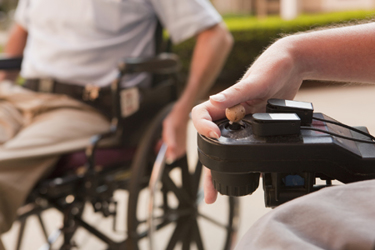Defining Meaningful Outcomes In Gene Therapy Trials For Duchenne Muscular Dystrophy
By Carl A. Morris, Roxana Donisa Dreghici, and J. Patrick Gonzalez, Solid Biosciences

Duchenne muscular dystrophy (DMD), the most common form of muscular dystrophy, is an X-linked recessive disease that affects approximately one in 5,000 live male births and is diagnosed in about 20,000 children globally each year.1 The disease results from mutations in the DMD gene that lead to the absence of functional dystrophin protein across skeletal and cardiac muscles. Dystrophin plays a central role as a structural protein in maintaining muscle membrane integrity, linking the intracellular actin cytoskeleton to the extracellular matrix. Importantly, it also acts as a mediator of molecular signaling pathways in anchoring neuronal nitric oxide synthase (nNOS) to the membrane. When properly localized, nNOS is able to regulate local tissue blood flow in response to high energy demand through the production of nitric oxide. In the absence of functional dystrophin protein, muscles are susceptible to contraction-induced injury and degenerate over time, leading to a progressive loss of skeletal and cardiac muscle function. DMD is typically diagnosed in early childhood and presents as delays in reaching developmental milestones in motor function.2,3,4 Patients with DMD on average do not live past their mid-20s, with the predominant causes of death being respiratory and cardiac failure.5
There is currently no curative therapy for DMD. Advances in standard of care have been made over the past decades leading to improved management of disease symptoms, but no meaningful disease-correcting therapies have yet been approved. Although DMD is a monogenic disease, the large size of the DMD gene, variety of mutations across patients, and requirement for functional dystrophin in muscles throughout the body have made therapeutic development difficult. However, based on clinical evidence that Becker muscular dystrophy (BMD) patients who express truncated forms of dystrophin display more mild phenotypes compared to DMD and the understanding of critical functional domains within the dystrophin protein, gene therapy approaches using shortened, rationally designed “microdystrophins” delivered by adeno-associated virus (AAV) have emerged. Multiple AAV microdystrophin gene therapy candidates, including SGT-001 in development by Solid Biosciences, are now currently being evaluated in clinical trials for the treatment of DMD to address this important unmet medical need.
Limitations Of Classical Therapeutic Endpoints
Standard clinical assessments used to evaluate DMD patients, such as the 6-minute walk test (6MWT), North Star Ambulatory Assessment (NSAA), and Performance of Upper Limb (PUL) scale, provide useful information on where a patient falls in his disease course but have limitations in their utility as therapeutic endpoints. In general, these limitations are related to motivational bias, inter-assessment variability, and lack of sensitivity. The first two assessments, 6MWT and NSAA, are focused on ambulation but use different methods to capture levels of function. The 6MWT was initially developed for older populations outside of DMD and asks a participant to walk as far as possible in a 6-minute period. While straightforward for an adult to comprehend, younger DMD patients commonly have difficulty with the request, mainly associated with the extended duration of the assessment and physical locations where the tests are performed. This introduces inter-subject, inter-time point, and inter-site variability. The NSAA, a DMD-specific test, incorporates the evaluation of 17 items to form a total score for ambulatory function. However, scoring across this assessment is prone to inter-observer variability due to small differences in how the ability to perform tasks can be perceived. The PUL scale, on the other hand, is specifically intended to assess upper limb function. Although this may initially be thought of as a more widely applicable assessment due to upper limb function being preserved longer than ambulatory function in DMD, decreases are not normally observed by this test until patients lose ambulation, making it less applicable to younger patients. Importantly, a common limitation of all three assessments is that they may not accurately reflect key patient and caretaker priorities that would be most meaningful to be preserved by therapeutic intervention. As a result, additional tools and strategies are necessary to accurately capture a patient’s disease state and the impact of a therapy.
Considering Novel Strategies To Capture Meaningful Changes
Pulmonary failure is an important cause of mortality in patients with DMD but has not commonly been a focus of endpoints included in therapeutic development. This is likely due to a lack of understanding of the changes expected in patients, especially at younger ages. However, as characterized in a DMD natural history study published by Mayer et al in 2015, a consistent annual decline in pulmonary function is observed across patients from the ages of 5 to 24. This is captured by both % predicted (%p) forced vital capacity (FVC %p) and peak expiratory flow (PEF %p) tests, with both showing similar declining trajectories over time. As a result, use of these assessments in even younger patients may provide insight into the potential for a therapy to improve, stabilize, or slow the decline of this critical function. Interim data from Solid Biosciences’ Phase 1/2 IGNITE DMD study (NCT03368742), where pulmonary function tests are evaluated, have demonstrated stabilization or improvement in FVC %p and PEF %p, compared to both individual patient baseline values and declines expected from natural history.
Characterization of muscle architecture, composition, and turnover has classically been assessed by analysis of muscle biopsies, limiting the frequency of these assessments and the utility of such an evaluation to provide more comprehensive information. Magnetic resonance imaging (MRI) approaches focused on capturing these changes in DMD skeletal muscle have more recently been established to non-invasively monitor parameters such as fat fraction that may be predictive of loss of function. Natural history studies are currently underway to better establish expected changes and correlations with functional outcomes over time to potentially utilize skeletal MRI assessments as biomarkers of DMD disease progression.
Multiple patient-reported outcome measures (PROMs) are also being evaluated for their ability to provide insight into both how patients experience DMD and the potential impact of DMD gene therapy on activities of daily life. The Pediatric Outcomes Data Collection Instrument (PODCI) is an established questionnaire-based tool that evaluates the important domains of global function, transfer/basic mobility, sports/physical function, upper extremity function, pain/comfort, and happiness with physical condition. In studies performed by Henricson, McDonald, and colleagues published in 2013, declines across these domains could be characterized on an annual basis in DMD patients. Interim data from the PODCI in the IGNITE DMD study of SGT-001 show improvements in treated patients across functional domains that may potentially represent meaningful changes to patients’ disease courses.
Technology-based assessments also have the potential to provide additional insight into the quality of a patient’s movement and changes over time. ActiMyo is a device that uses magneto-inertial technology to enable precise positioning, orientation, navigation, and motion capture to measure a patient’s movement across real-world settings. In 2019, it received approval from the European Medicines Agency as an endpoint for ambulatory patients with DMD.6 Using a similar approach, KineDMD is a study evaluating a wearable bodysuit containing multiple sensors to capture patient motion. Data from the sensors are analyzed using artificial intelligence to detect patterns of movement that can be used to objectively monitor disease progression. An interim analysis of this study identified static and dynamic differences in motor coordination between DMD patients and healthy controls and results suggest that integration of sensor technology with machine learning can enable the development of digital biomarkers that can be assessed in real-world environments.7 The Duchenne Video Assessment (DVA)8 is a home-based video assessment tool being developed to measure changes in the quality of DMD patient movement, potentially providing greater insight into a patient’s abilities. Initial testing of this tool found statistically significant differences between severity groups for movement tasks, potentially indicating that it could be a reliable and valid tool for measuring the quality of movement in patients with DMD.
Defining Meaningful Outcomes In DMD Trials Is An Urgent Need
With multiple DMD gene therapies moving toward late-stage clinical trials, it is becoming critically important to identify endpoints that can meaningfully assess changes in function and quality of life to enable patients, physicians, caregivers, regulators, and payors to make informed decisions. Given that DMD impacts diverse anatomic systems and a variety of quality-of-life issues, composite endpoints that reflect improvement in multiple domains may be appropriate for supporting approval. Similarly, real-world evidence should also be considered when determining the risk-benefit profile of a DMD gene therapy and making approval decisions. Defining endpoints should be a collaborative effort that includes and reflects the needs and priorities of patients, physicians, industry, regulators, and payors and is based on robust data.
References
- Mendell JR, Shilling C, Leslie ND et al. Evidence-based path to newborn screening for Duchenne muscular dystrophy. Ann Neurol.. 2012;71:304-313.
- Blake DJ, Weir A, Newey SE and Davies KE. Function and genetics of dystrophin and dystrophin-related proteins in muscle. Physiol Rev. 2002;82:291-329.
- Birnkrant DJ, Bushby K, Bann CM et al. Diagnosis and management of Duchenne muscular dystrophy, part 1: diagnosis, and neuromuscular, rehabilitation, endocrine, and gastrointestinal and nutritional management. Lancet Neurol. 2018;17(3):251-267.
- Birnkrant DJ, Bushby K, Bann CM et al. Diagnosis and management of Duchenne muscular dystrophy, part 2: respiratory, cardiac, bone health, and orthopaedic management. Lancet Neurol. 2018;17(4):347-361.
- Broomfield J, Hill M, Guglieri M, Crowther M and Abrams K. Life expectancy in Duchenne muscular dystrophy. Neurol. 2021;97(23) e2304-e2314; DOI:10.1212/WNL.0000000000012910
- Servais L, Camino E, Clement A et al. First regulatory qualification of a novel digital endpoint in Duchenne muscular dystrophy: a multi-stakeholder perspective on the impact for patients and for drug development in neuromuscular diseases.
- Ricotti V, Kadirvelu B, Selby V, Voit T and Faisal A. Towards high-resolution clinical digital biomarkers for Duchenne muscular dystrophy. Neuromuscular Disorders. 2019;29(S1):S108.
- Contesse MG, Sapp AT, Apkon SD, Lowes LP, Dalle Pazze L and Leffler MG. Reliability and construct validity of the DMD Video Assessment. Muscle & Nerve. 2021;1-10.
About The Authors:
 Carl Morris, Ph.D., is Chief Scientific Officer at Solid Biosciences. He is responsible for overseeing all of the company’s clinical programs. Previously, Morris was a senior director for Pfizer’s Rare Disease Research Unit, leading their efforts in neurologic diseases and muscle biology programs. Before that, he was an assistant professor at Boston University School of Medicine and was founding faculty member for their Muscle and Aging Research Unit. Morris completed his postdoctoral fellowship in the Department of Physiology at the University of Pennsylvania and holds a B.A. in biology from Franklin Pierce College and a Ph.D. in physiology from UCLA.
Carl Morris, Ph.D., is Chief Scientific Officer at Solid Biosciences. He is responsible for overseeing all of the company’s clinical programs. Previously, Morris was a senior director for Pfizer’s Rare Disease Research Unit, leading their efforts in neurologic diseases and muscle biology programs. Before that, he was an assistant professor at Boston University School of Medicine and was founding faculty member for their Muscle and Aging Research Unit. Morris completed his postdoctoral fellowship in the Department of Physiology at the University of Pennsylvania and holds a B.A. in biology from Franklin Pierce College and a Ph.D. in physiology from UCLA.
 Roxana Donisa Dreghici, MD, is the senior vice president, head of clinical development at Solid Biosciences. She has served in senior scientific leadership roles at F. Hoffmann La Roche, Santhera, Novartis, Novo Nordisk, and Quintiles, most recently as global development lead/associate group medical director for neuromuscular diseases for F. Hoffmann La Roche in Basel, Switzerland. A native of Romania, Dreghici received her medical degree from Iuliu Hațieganu University of Medicine and Pharmacy, Romania.
Roxana Donisa Dreghici, MD, is the senior vice president, head of clinical development at Solid Biosciences. She has served in senior scientific leadership roles at F. Hoffmann La Roche, Santhera, Novartis, Novo Nordisk, and Quintiles, most recently as global development lead/associate group medical director for neuromuscular diseases for F. Hoffmann La Roche in Basel, Switzerland. A native of Romania, Dreghici received her medical degree from Iuliu Hațieganu University of Medicine and Pharmacy, Romania.
 Patrick Gonzalez, Ph.D., is the director of clinical science at Solid Biosciences. Gonzalez is a muscle biologist by training, having spent a majority of his research career focused on characterizing the molecular biology and physiology associated with Duchenne muscular dystrophy. Since joining Solid Biosciences in 2016, he has led non-clinical pharmacology and clinical bioanalytical and functional analysis efforts, collaborating closely with academic research, clinical, and industry partners. He holds a Ph.D. in cell biology and molecular medicine from Rutgers University and a B.S. in biochemistry from Syracuse University.
Patrick Gonzalez, Ph.D., is the director of clinical science at Solid Biosciences. Gonzalez is a muscle biologist by training, having spent a majority of his research career focused on characterizing the molecular biology and physiology associated with Duchenne muscular dystrophy. Since joining Solid Biosciences in 2016, he has led non-clinical pharmacology and clinical bioanalytical and functional analysis efforts, collaborating closely with academic research, clinical, and industry partners. He holds a Ph.D. in cell biology and molecular medicine from Rutgers University and a B.S. in biochemistry from Syracuse University.
